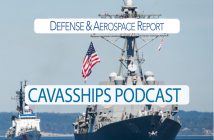Welcome to the CavasShips Podcast with Christopher P. Cavas and Chris Servello…a weekly podcast looking at naval and maritime events and issues of the day – in the US, across the seas and around the world. This week…Everyone talks about how big a Navy the United States needs. Right after that is how much would such a Navy cost? There is no better expert on the topic of what the U.S. would spend on its Navy than today’s guest, Eric Labs of the Congressional Budget Office. Eric will join us for a deeper dive into his newly-released analysis of the costs of the Navy’s current shipbuilding plans.
Please send us feedback by DM’ing @CavasShips or @CSSProvision or you can email chriscavas@gmail.com or cservello@defaeroreport.com.
This Week’s Naval Round Up:
More than half the US Navy’s carrier fleet remained underway during the past week. The deployed GERALD R FORD CVN78 Carrier Strike Group continues on station in the eastern Mediterranean while the DWIGHT D EISENHOWER CVN69 strike group transited the Suez Canal on November 4 and is operating in the Red Sea along with the BATAAN LHD5 Amphibious Ready Group. In the Pacific the RONALD REAGAN CVN76 and CARL VINSON CVN70 strike groups came together for at least two days of combined operations in the Philippine Sea November 6 and 7 along with the Japanese light carrier HYUGA. In the US, non-deployed carriers GEORGE WASHINGTON CVN73 on the east coast and NIMITZ CVN68, THEODORE ROOSEVELT CVN71 and ABRAHAM LINCOLN CVN72 on the west coast have been underway on training operations. Of the remaining three carriers in the US fleet, HARRY S TRUMAN CVN75 is in the back end of a year-long drydocking overhaul at Norfolk Naval Shipyard, GEORGE H W BUSH CVN77 is undergoing a pierside availability overhaul at Norfolk Naval Station, and the JOHN C STENNIS CVN74 remains in the midst of a major refueling overhaul at Newport News Shipbuilding in Virginia. While four carriers deployed at once and eight overall of the fleet’s eleven flattops are underway, the unusually high number is the result of a series of planned and individual scheduling situations and is not a specific response to current worldwide events. It also means that at some point in the future, as it was just a couple of years ago, there might not be nearly that many carriers available for operations.
Another significant ship movement in the Mideast took place November 5 when the cruise missile/special operations submarine USS FLORIDA passed southbound through the Suez Canal to enter the Central Command area of responsibility. FLORIDA has most recently been operating in northern Europe. A photo of the sub passing through the canal was widely distributed by the Pentagon.
In the Russia-Ukraine War, a Ukrainian cruise missile apparently hit the new Russian Karakurt-class missile corvette ASKOLD on November 4 while the Russian warship was at the Kerch shipyard in Russian-occupied eastern Crimea. The missile is thought to have been a French-built SCALP-EG or Storm Shadow weapon. Damage to the ASKOLD, which only entered service a year ago, is thought to be significant.
USS PINCKNEY DDG 91 got underway from San Diego November 7 for sea trials following a significant modernization overhaul that included the first installation of the Surface Electronic Warfare Improvement Program, or SEWIP, SLQ-32(V7) variant of the widely-used SLQ-32 electronic warfare system. The Block 3 SEWIP work was done at GD NASSCO in San Diego and involved significant structural additions to each side of the PINCKNEY’s bridge superstructure that radically changed the ship’s appearance, especially from when seen from ahead. In addition to the far more powerful V7 EW system, the structures, dubbed chipmunk cheeks by some, also contain cooling systems for the upgrades, which include an electronic attack capability.
And the new littoral combat ship USS MARINETTE LCS25 got underway from Cleveland, Ohio November 4 after spending two weeks on the Lake Erie waterfront while a strike closed the Saint Lawrence Seaway leading from the Great Lakes to the sea. The ship was at Quebec City on November 10, headed eventually for her homeport of Mayport, Florida.
And in other new ship news, a keel ceremony for the new towing, salvage and rescue ship BILLY FRANK T-ATS 11 is to be held November 14 in Mobile, Alabama, where it will become the first ship of the type to be built by Austal USA.
And in new aircraft news – albeit new U.S. Air Force aircraft news – the first B-21 Raider stealth bomber made its first flight November 10, a ferry flight from Northrop Grumman’s production facility in Palmdale, California to Edwards Air Force Base for an extensive series of flight tests. The B-21, which outwardly looks little different from the B-2 Spirit bomber, will replace existing B-1 and B-2 bombers in the long-range strike role and is intended to serve alongside the exceptionally venerable and long-serving B-52H Stratofortress.
Cavas Squawk:
I don’t think it’s any secret that when you listen to this podcast you’re listening to a couple of confirmed navalists. Mister Servello and I believe in the value of a strong Navy in war and in peace – both to win a war and to keep the peace, and for everything n between. It’s a lesson that has rung down through history from ancient times. Armies have almost never brought long-term stability, but navies most certainly have.
Navy officials have little choice other than to remain part of the political process – in the Pentagon, in whatever presidential administration is in charge, and in testimony before a chronically politically-charged Congress. Officials have to be careful how they couch things, mindful of the reactions of politicians, and keeping to strict rules about the federal acquisition process.
But just about any analysis of the Navy’s current and recent shipbuilding programs usually produces a common response – why isn’t the Pentagon doing more to support, maintain and expand the nation’s seapower? The primary peer competitor came to the conclusion some years back that seapower was a prime requirement and that a major investment in a Navy would pay significant dividends, and the Chinese Navy is now, numerically, the world’s largest Navy. It’s also increasingly becoming an instrument for political and power projection – not just throughout the turbulent South China Sea, but increasingly, worldwide. And what they’ve done, in many ways, has been to build a copy of the United States Navy at its peak.
But it does not seem that here in the U.S., those in charge at the very top, regardless of the party or administration, really get the value of seapower. The annual budget submission always seems to be for a Navy with one hand tied behind its back, making major investments in a handful of areas but restricted in most others. Don’t get me wrong – I’m most certainly not advocating for a blank check, and I hate wasting money and resources. But year in and year out it seems the service could be asking for more and doing a better job inside the Pentagon of advocating for its needs.
Congress certainly agrees. For all the messiness and downright ugliness of recent years, Doctor Labs points out that every year since 2014, the House and Senate have provided significantly more in shipbuilding funds than the Navy asked for. The sentiment on the Hill has been, for quite some time, why don’t you ask for more? That’s across the aisles, across both houses, regardless of who’s in the White House. Nobody wants to waste money, but clear majorities on Capitol Hill want to be doing more.
So – and I’m directing this at the White House and Pentagon leadership as well as the Navy — why don’t we ask for more? The clock is running.




